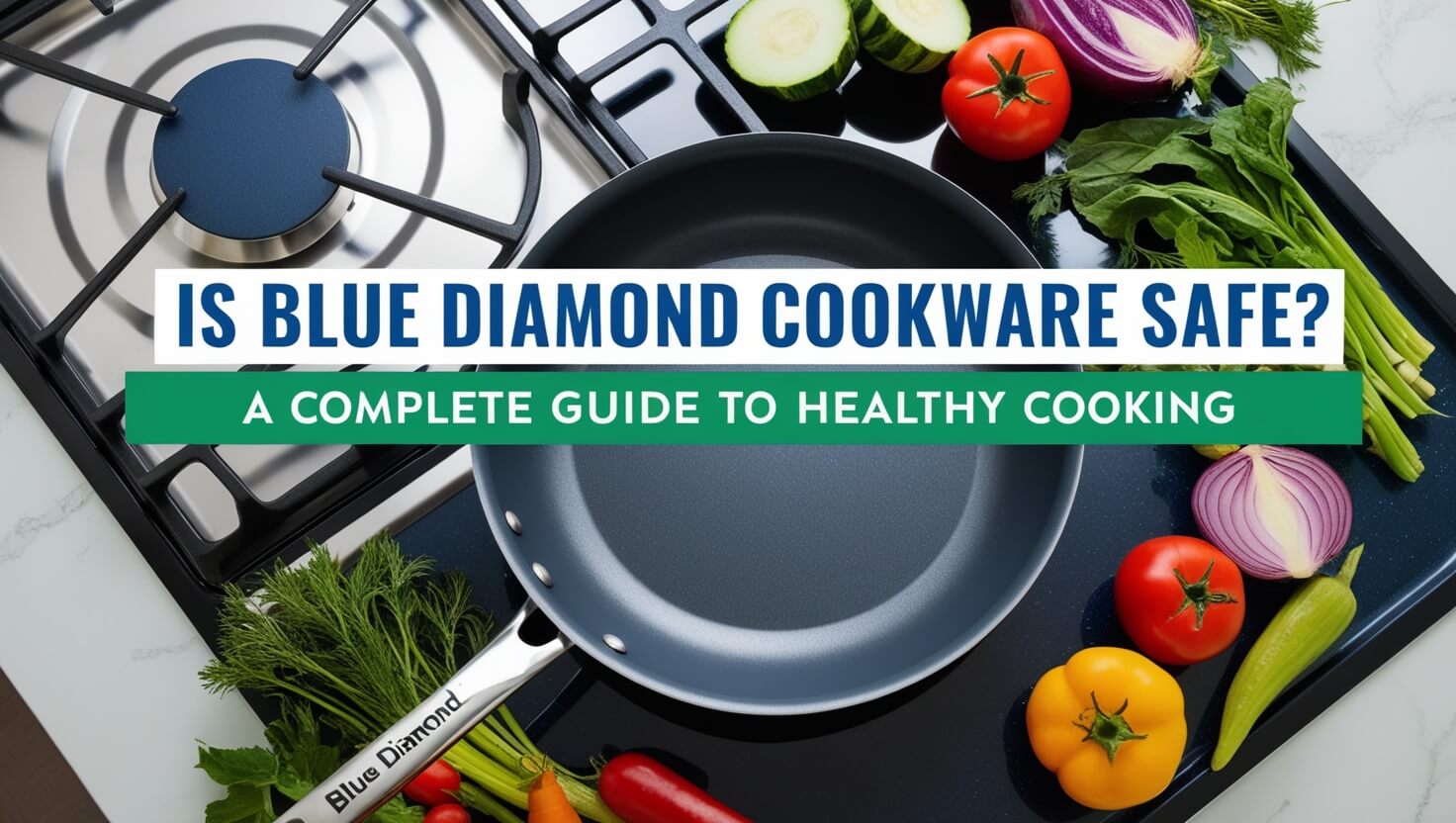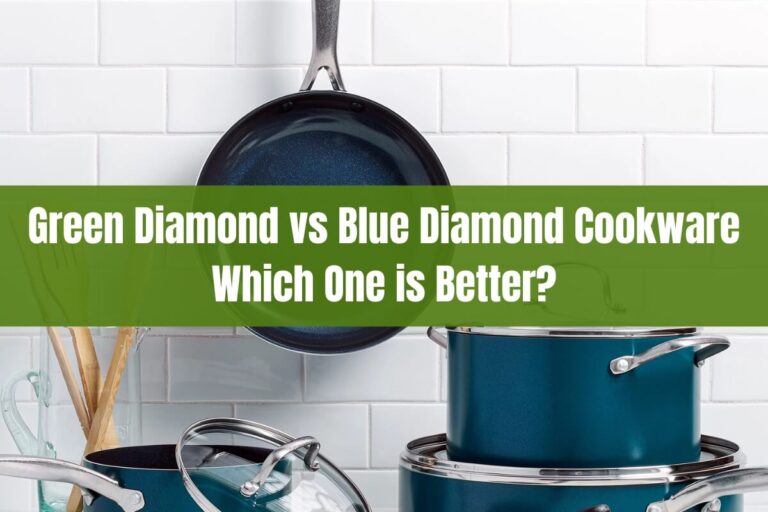
Blue Diamond cookware has gained popularity for its diamond-infused ceramic nonstick coating. Many home cooks wonder about its safety, and the good news is that Blue Diamond cookware is generally considered safe for everyday use. This article explores the safety aspects of Blue Diamond cookware, its technology, and how it compares to other cookware options.
What is Blue Diamond Cookware?
Blue Diamond is a brand that offers a range of cookware products featuring their signature diamond-infused ceramic nonstick coating. The company claims this coating provides superior nonstick performance and durability compared to traditional nonstick surfaces.
Overview of Blue Diamond brand
Blue Diamond entered the cookware market with a mission to provide high-quality, nonstick cookware without harmful chemicals. Their products include frying pans, saucepans, bakeware, and cookware sets.
Types of Blue Diamond cookware products
Blue Diamond offers various cookware lines:
- Classic: The original Blue Diamond collection
- Triple Steel: Stainless steel cookware with the diamond-infused coating
- Hard Anodized: Durable cookware with enhanced heat distribution
- Ceramic: Pure ceramic cookware options
The Technology Behind Blue Diamond Cookware
Understanding the technology used in Blue Diamond cookware helps explain its safety profile.
Diamond-infused ceramic nonstick coating
Blue Diamond’s signature coating starts with raw materials derived from silicon dioxide (sand). The coating includes diamond particles, which the company claims enhance heat conduction and durability.
How Blue Diamond’s coating differs from traditional nonstick
Unlike traditional nonstick coatings that often use PTFE (polytetrafluoroethylene), Blue Diamond’s ceramic coating is PTFE-free. This difference is crucial when considering the safety of the cookware.
Safety Concerns with Nonstick Cookware
To appreciate Blue Diamond’s safety claims, it’s important to understand common concerns about nonstick cookware.
Common chemicals in nonstick coatings
Many nonstick pans use PTFE, often known by the brand name Teflon. Some older nonstick coatings contained PFOA (perfluorooctanoic acid), which raised health concerns.
Potential health risks of PFAS and PTFE
PFAS (per- and polyfluoroalkyl substances) and PTFE have been linked to various health issues when released at high temperatures. This risk has led many consumers to seek alternatives.
Blue Diamond’s Safety Claims
Blue Diamond makes several claims about the safety of their cookware.
PFAS-free and PFOA-free statements
Blue Diamond proudly states that their cookware is free from PFAS and PFOA. This claim addresses a major safety concern associated with some nonstick cookware.
Absence of lead and cadmium
The company also asserts that their products are free from lead and cadmium, two heavy metals that can be harmful if they leach into food.
Third-party certifications
Blue Diamond reports that their cookware has been certified by third-party labs to meet FDA and EU food contact standards. However, it’s worth noting that independent verification of these claims is limited.
Analyzing Blue Diamond’s Nonstick Coating
Let’s take a closer look at what makes up Blue Diamond’s coating and how it performs.
Composition of the ceramic nonstick surface
The ceramic coating starts with silicon dioxide-based materials. The addition of diamond particles is said to enhance the coating’s properties, though the exact composition is proprietary.
Heat resistance and toxin release
Blue Diamond claims their cookware can withstand temperatures up to 850°F (450°C) without releasing toxic fumes. This heat resistance is higher than many traditional nonstick coatings.
Durability and Performance of Blue Diamond Cookware
Safety isn’t the only concern for cookware users. Durability and performance also matter.
Scratch resistance and metal utensil safety
While Blue Diamond states their coating is tough enough for metal utensils, they recommend using softer utensils to preserve the nonstick surface.
Heat distribution and cooking efficiency
The diamond-infused coating supposedly conducts heat better than conventional nonstick, potentially allowing for more efficient cooking at lower temperatures.
Proper Use and Care for Blue Diamond Cookware
To maintain safety and performance, proper use and care are essential.
Recommended cooking temperatures
Blue Diamond recommends cooking on low to medium heat. This advice helps prevent overheating and prolongs the life of the nonstick coating.
Cleaning and maintenance tips
Hand washing with mild soap and warm water is recommended. Avoid harsh scrubbers or abrasive cleaners that could damage the nonstick surface.
Environmental Impact of Blue Diamond Cookware
For eco-conscious consumers, the environmental impact of cookware is an important consideration.
Manufacturing process and emissions
Blue Diamond claims their coating curing process creates 60% fewer CO2 emissions compared to conventional nonstick coatings. They also state that 30% of their factory’s power comes from solar panels.
Recyclability and eco-friendliness
While the cookware’s body is often made from recyclable materials like aluminum, the nonstick coating makes recycling the entire product challenging.
Comparing Blue Diamond to Other Cookware Options
How does Blue Diamond stack up against other cookware types?
Blue Diamond vs. traditional nonstick
Blue Diamond’s ceramic coating offers a PTFE-free alternative to traditional nonstick, potentially reducing health risks associated with overheating.
Blue Diamond vs. stainless steel and cast iron
While stainless steel and cast iron are known for durability and safety, they lack the nonstick properties of Blue Diamond. However, they’re generally considered more durable in the long term.
Consumer Reviews and Experiences
Real-world experiences can provide valuable insights into Blue Diamond’s performance and safety.
Positive feedback on Blue Diamond cookware
Many users praise the initial nonstick performance and ease of cleaning. Some report being able to cook with less oil, which they view as a health benefit.
Common complaints and concerns
Some consumers have noted that the nonstick properties diminish over time, despite following care instructions. Others have reported issues with durability, such as chipping or scratching.
Expert Opinions on Blue Diamond’s Safety
What do experts in food safety and cookware say about Blue Diamond?
Insights from food safety experts
Many experts agree that ceramic nonstick coatings like Blue Diamond’s are generally safe when used as directed. However, they caution that long-term studies on these newer materials are limited.
Cookware industry perspectives
Industry professionals often note that while ceramic coatings offer benefits, they may not match the longevity of traditional nonstick or materials like stainless steel.
FAQs About Blue Diamond Cookware Safety
Let’s address some common questions about Blue Diamond cookware safety.
Is Blue Diamond cookware oven-safe?
Yes, most Blue Diamond cookware is oven-safe up to 600°F (315°C), but always check the specific product instructions.
Can I use metal utensils with Blue Diamond cookware?
While the company claims the surface is metal utensil safe, using wooden, silicone, or nylon utensils can help preserve the nonstick coating.
Does Blue Diamond cookware contain PTFE?
No, Blue Diamond states that their cookware is PTFE-free.
Is Blue Diamond cookware dishwasher-safe?
Many Blue Diamond products are dishwasher-safe, but hand washing is recommended to prolong the life of the nonstick coating.
How long does the nonstick coating on Blue Diamond cookware last?
The lifespan of the coating can vary based on use and care. Some users report excellent performance for years, while others notice a decline in nonstick properties over time.
Conclusion: Is Blue Diamond Cookware a Safe Choice?
After examining the available information, Blue Diamond cookware appears to be a safe option for most home cooks. Its ceramic nonstick coating avoids many of the chemicals of concern in traditional nonstick cookware. The absence of PFAS, PFOA, lead, and cadmium addresses major safety concerns.
However, it’s important to note that while Blue Diamond makes strong safety claims, independent long-term studies on this specific cookware are limited. As with any cookware, proper use and care are crucial for maintaining safety and performance.
For those looking to avoid PTFE-based nonstick coatings, Blue Diamond offers an alternative worth considering. Yet, consumers should weigh factors like durability, cooking performance, and personal preferences when choosing cookware.
Ultimately, when used as directed, Blue Diamond cookware can be a safe addition to your kitchen. As with any cooking tool, informed use and proper care are key to getting the best and safest performance from your Blue Diamond pots and pans.






